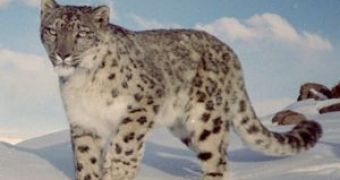For the first time, scientists in Pakistan have managed to attach a Global Positioning System (GPS) collar to a snow leopard (photo) to track the trail of the most elusive big cat in order to achieve vital information for efforts to save the endangered species.
Over the next few months, the international team hopes to fit four more snow leopards with the high-tech collars. A 35 kg female snow leopard was captured on the Purdum Mali ridge in the Chitral Gor National Park in north Pakistan. "It is the first time that a satellite tracking device has been put on them and they are being tracked through the global positioning system," said Amjad Aslam of the WWF-Pakistan.
"We'll be getting information almost on-line."
"Thanks to their solitary nature, the steep, rocky terrain they inhabit, and their twilight activity, snow leopards are extremely difficult to study," says Ashley Spearing from the research team. "Snow leopards are nocturnal, they live at an altitude which is not very healthy for human beings and they are also very elusive so we really don't know a lot about them," added Aslam. "By looking at this tracking data we'll know their home range -- what is the minimum area a snow leopard requires to live and thrive."
"The biggest thing this project will tell us is how much space a snow leopard needs." said Brad Rutherford, director of the Snow Leopard Trust. "And you would think in 2006 that we would have that answer, but unfortunately, because the cats are so elusive, we don't. Estimates range between 65 sq km and 1,000 sq km."
"You cannot have an appropriately sized protected area with that kind of discrepancy."
Till now, most of the information on snow leopard biology has been based on anecdote, extrapolation or older research using less-accurate radio collars. "This study is the first time GPS technology has been used to track snow leopards. It is going to give us very accurate, detailed knowledge of the size of the cats' home range and the sort of day-to-day movements they make." said Spearing.
The collar pinpoints the exact position of the leopard several times a day via satellite. The hardest part of the study is capturing the felines because of their secretive lifestyle and the habitat of difficult access, along ridgeways and cliff bases. "We use those marking sites to place non-invasive foot snares," said Mr Spearing. "They also contain a radio-device so when it is triggered, it sends a signal to let us know."
Each morning, the researchers go out at -5C to -20C to check the snares, walking about 10-13km (6-8 miles) and climbing 600-900m (2,000-3,000ft). Snared animals are anaesthetized, assessed for age, sex, size and weight, and then collar fitted and released.
The fact that the team has captured a snow leopard so early on in the project has given the researchers hope that they will be able to collar their target of five cats. After 14 months the collar drops off. Snow leopards live at high altitudes in the mountains of central Asia and Himalaya. The number of individuals in the wild is estimated between 3,500 to 7,000, 200 to 420 being found in Pakistan.
The species has been on the IUCN's Red List of endangered species since 1972, at risk from habitat fragmentation, depletion of prey, hunting for pelt and bone, and retaliation killings from livestock herders. "There's an urgent need to conserve them," Aslam said.
The species is under threat as poachers chase snow animals for their bones, which are used in awful Chinese medical folk practices in the same manner as tiger bones, and for their thick pelts. Remote as their habitat is, these cats are in growing competition with humans for food because people move higher and higher into the mountains hunting the wild sheep and goats the snow leopards rely upon. "Once their prey has been reduced the snow leopard tends to attack livestock, so retaliatory killings are quite common," Aslam said.
WWF plans a program under which shepherds losing animals to snow leopards can get compensation, in order to dissuade villagers from chasing them. The GPS data will clearly show if the cats avoid human habitats or haunt around livestock folds. "All of this information will help us to craft better conservation efforts on the ground," he says.

 14 DAY TRIAL //
14 DAY TRIAL //